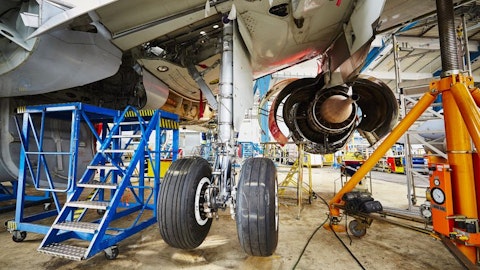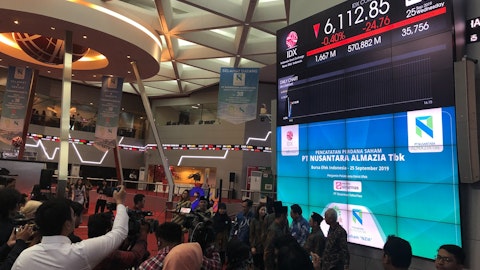Kenneth Herbert: Hey, I just maybe wanted to start. You’ve got — Martin, to your point, you’ve got almost $330 million sort of in inventory or assets you can monetize on the balance sheet. It sounds like you’ve got agreements for an incremental $83 million to purchase. And you’ve already sold maybe $30 million or so this quarter, in the first quarter – data if I got that right. I know it’s hard to predict and there is obviously a lot of customer issues, but really two questions. One, can you give any more granularity, aside from maybe the 757s, on what sort of broad buckets or what type of assets you hold? Because are these maybe engines where there just isn’t much near-term demand or airframe? And how much could that 330, you know, how much lower could the inventory balance be exiting ’24 if everything goes according to plan, considering you’re obviously still committing capital to feedstock.
Martin Garmendia: So the majority of the inventory that we have on hand is engine-related and we have engines that are in demand. We have CFM56, CF6-80s, RB211. So I think that’s really going to put us in a position to not only support USM sales, but opportunities in the leasing market to do the customized type of leases that we do short term in nature, getting a much higher return than the typical sub-1% monthly lease rate factors, that a pure play leasing company would be able to obtain. You know, a smaller portion of that inventory is airframe material, again supporting the 737 and 757 overall platforms. And again, that material is in high demand to continue to service those overall fleets. So we feel good about those opportunities.
Ken, as I mentioned earlier, the real challenge is here — what avenue do we take to monetize these? We’re seeing a pretty good leasing market, and when we look at that from a long-term perspective, those returns are attractive, obviously with the availability or with limited kind of assets being available for sale. These assets are also demanding a premium from a trade perspective. So again, we’re always looking at what is the best long-term kind of view and objective. And that’s really what’s driving us kind of pulling that overall guidance because we want to be opportunistic, we want to be able to maximize that and not be kind of triggered to meeting a specific quarterly or year-to-date number.
Kenneth Herbert: Okay. Thanks, Martin. I mean, I can appreciate the desire to sort of maximize the return, but just considering sort of the EBITDA in ’23 and a question we get a lot. I mean, maybe — at what point would you maybe have just — maybe a bit of greater sense of urgency around some of this monetization of these assets to just make room for more inventory, maybe just accelerate the push-off the balance sheet a bit?
Martin Garmendia: Yeah. I would say —
Nicolas Finazzo: Let me answer that. So, we sell what we have more or less 757s aside. We sell what we have available when it’s ready for sale. So the demand is there. It’s very strong demand in the marketplace for USM, for engines. The issue is getting it through the system and getting it available for sale and dealing with all of the dynamics in the market today about long lead times for any type of work, whether it’d be repairing an engine, repairing a piece part, overhauling an aircraft. So the — there is a sense of urgency, I can assure you, Ken. I’m getting this — getting whatever we have made ready for sale. And the issue isn’t that we’re not prioritizing the make ready nature of whatever it takes to get these assets available for sale.
We are prioritizing it. Some of the decisions we make, however, could be longer, such as taking engine parts that we pulled out of an engine or aircraft that we bought and deciding that, yeah, we could turn this, and by the way this is a struggle that we have every day. And we could sell it as USM to somebody else that’s overhauling an engine. And would love to get their hands on the coveted life-limited parts that we have, that we were able to pull from an engine we bought for part out, and some of the other parts out there to get a low-cost engine that they would then build and supply their customer. So we’ll pull those. And now we lose a short-term sale, and that goes into work, and it goes into an engine. And then we run that through the whole process of getting the engine overhauled.
And instead of having an immediate sale from a part that we had ready, now it’s in the repair process of getting an engine done, and then we’re done with that. Then we’re fighting with, well, do we sell it? Because the market is really red hot on this engine type today, and we can get a premium over what we think we could get in the short run, or do we go the long route, which is to put the engine on lease. So it’s not that there’s not a sense of urgency. It’s that the quickest return is not always the best return. And we have a long-term view of building up this company’s profitability and not taking — and not doing things in the short term that will impact the business over the long run. Now, I know that that’s not what investors want to hear, because everybody wants to see short-term returns, as do we.
But we consistently look to do what’s best for the business, and we don’t focus on just the short term.
Kenneth Herbert: Yeah. No, Nick, I appreciate that. And I guess, it’s your — as a public company, you’re obviously having to walk a very fine line between sort of managing near, mid, and long-term expectations. So definitely, appreciate that. I guess as I think about, again the carrying value or the inventory on the balance sheet as you — as this becomes available, and as you look to monetize it. Back to one of the earlier questions, is there any reason to think that this value wouldn’t support the kind of gross margins we saw in ’21 and ’22?



